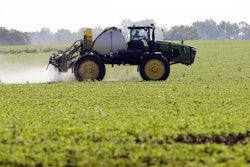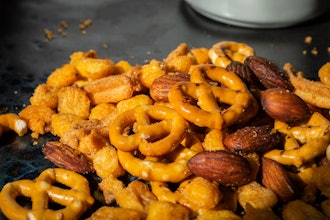WILLIAMS, Calif. (AP) — The rust-orange head of an American avocet darted back and forth watching for predators, its black-and-white feathered body plopped atop a nest of four speckled eggs that lay on an earthen levee in a California rice paddy.
"It's a full clutch of four eggs," said Monica Iglecia, a shorebird biologist with Audubon California, looking through binoculars. "This is why we do this work. It's exciting to see."
The hundreds of vast, flooded rice paddies that cover miles of interior northern California may seem like an unlikely safe haven for shorebirds, but changes occurring in the state's rice country may help improve the outlook for dozens of species in decline in recent decades. So far, more than 165 rice farmers have signed up for an incentive program that will build a system of islands and other habitat improvements in their paddies, and provide birds like the avocet a place to rest, feed and breed throughout the year.
The incentive, funded by $2 million from the U.S. Natural Resources Conservation Service, helps defray the costs of building the islands or of new equipment needed to make levees and other farm infrastructure more amenable as habitat.
California's rice farms lie in a region where about 95 percent of the native wetlands that once provided habitat for migratory and water birds have disappeared. The state's rice paddies, which produce much of the sushi rice consumed in the U.S., take up more than a half million acres in the Sacramento Valley while protected wetlands cover a little more than 77,000 acres.
Even with shrinking wetlands, this valley that stretches from the state capital north about 160 miles to Redding is a part-time home to cinnamon-teal ducks, dowitchers, dunlins, black-necked stilts and dozens of other migratory water birds.
Migratory birds face a number of perils, not least among them the effects of climate change, which is expected to reduce the Sierra Nevada snowpack and the amount of water feeding the remaining wetlands, said Khara Strum, a water bird ecologist with PRBO Conservation Science.
As natural bird habitat dwindles, California's Sacramento Valley falls under a flight pattern known as the Pacific Flyway, a major route for migratory birds that stretches from Alaska to Patagonia. So biologists see a significant opportunity in adding to and improving habitat on the only other wetlands that proliferate here: rice farms.
Jim LaGrande, a farmer whose family has grown rice in the region for generations, has flattened the tops of the 2,200-foot-long dirt levees that regulate the flow of Sacramento River water he uses to flood his paddies. The hip-high levees for generations had been built in an "A-frame" like mound that made nesting difficult.
On a sweltering afternoon at LaGrande's farm, black-necked stilts darted around his paddies looking tuxedo clad. Brown-and-white killdeer skittered about with small least sandpipers, all birds that had come to the area to breed.
"I feel I am privileged to be able to come out every day and witness a wonderful environment with wildlife," LaGrande said, standing in blue jeans and a denim shirt overlooking a bright green field of short-grain sushi rice. "To be the person who is actually able to provide enhancements to aid this process gives me a feeling of accomplishment in doing my part in nature's way."
Beyond building islands and other new habitat, the farmers are changing the way they manage the water they use to flood the paddies. In late winter, many farmers drain the fields to begin the grow cycle anew, resulting in the sudden disappearance each year of thousands of acres of wetland habitat for the birds.
LaGrande and the other farmers have agreed to begin gradually draining their fields, leaving some partially flooded for birds that like to feed and rest in shallow, muddy areas.
"We are doing a variable draw down now, keeping water in the fields longer for different species that like different water heights," he said.
To get the incentive funds, the farmers apply to the conservation service, which sends a representative out for a field visit to discuss the project and rank the application. Generally, the incentive program covers about half the costs the farmer will incur.
As with many such undertakings, it remains to be seen whether the plan will work, and Iglecia of Audubon said it is still too early to tell if the birds will take a liking to the islands. But there are promising signs, she said, like the avocet and other bird nests that have been cropping up on the rice paddy levees.
It will take at least two years of gathering data for scientists ascertain whether they are on to something, but they are grateful to the farmers for allowing the experiment, which covers a fraction of the state's rice paddies, to occur at all.
"If you want to do conservation here, you've got to be able to work with private landowners," Strum said. "It's been a win-win for conservationists and the farmers, with ecological and economic benefits."






















